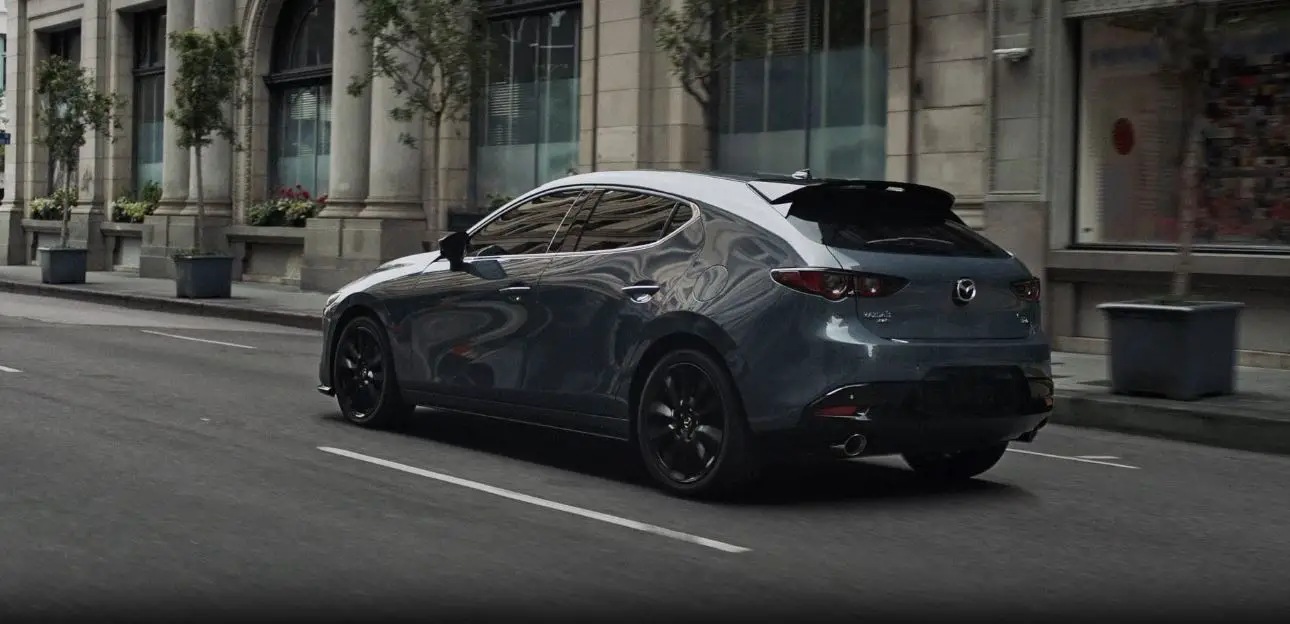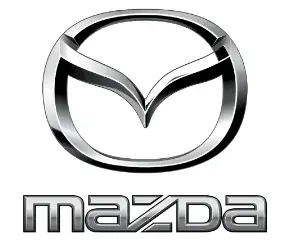 Mazda 3 Hatchback 2023 Child Restraint User Manual
Mazda 3 Hatchback 2023 Child Restraint User Manual
Introduction
A well-liked and fashionable compact car created to offer a relaxing and delightful driving experience is the Mazda 3 Hatchback 2023. The Mazda 3 Hatchback puts safety first in addition to its remarkable performance and cutting-edge technology, especially when it comes to kid restraints. Mazda understands the value of safeguarding young passengers and has added a number of measures and technology to the car to assure their safety. The vehicle has a complete kid restraint system that complies with the strictest safety regulations. The Mazda 3 Hatchback 2023’s sophisticated seat belt system, which includes three-point seat belts for all seating locations, including the rear seats, is one of its standout characteristics. These seat belts are made to safely restrain both adults and children, reducing the risk of injuries in the event of an accident. The LATCH (Lower Anchors and Tethers for Children) system is included with the Mazda 3 Hatchback in addition to the seat belts. This system offers standardized attachment points for child safety seats in the back seats, enabling quick and safe installation. The LATCH system lowers the likelihood that child restraints will become unsecured or unstable during a collision by assisting with appropriate installation.
Child Restraint
Child-Restraint Precautions Mazda strongly urges the use of child-restraint systems for children small enough to use them. You are required by law to use a child-restraint system for children in the U.S. and Canada. Check your local and state or provincial laws for specific requirements regarding the safety of children riding in your vehicle. Whatever child-restraint system you consider, please pick the appropriate one for the age and size of the child, obey the law and follow the instructions that come with the individual child-restraint system. A child who has outgrown child-restraint systems should sit in the rear and use seat belts, both lap and shoulder. If the shoulder belt crosses the neck or face, move the child closer to the center of the vehicle in the outboard seats, and towards the buckle on the right if the child is seated on the center seat. Statistics confirm that the rear seat is the best place for all children up to 12 years of age, and more so with a supplemental restraint system (air bags). A rear-facing child-restraint system should NEVER be used on the front seat with the air bag system activated. The front passenger’s seat is also the least preferred seat for other child-restraint systems.
(With Front Passenger Occupant Classification System)
To reduce the chance of injuries caused by deployment of the front passenger air bag, the front passenger seat weight sensors occupant classification sensor works as a part of the supplemental restraint system. This system deactivates the front passenger front and side air bags and knee air bags, and also the front passenger seat belt pretensioner system when the front passenger air bag deactivation indicator light illuminates. When an infant or small child sits on the front passenger seat, the system shuts off the front passenger front and side air bags and knee air bags, and seat belt pretensioner system, so make sure the front passenger air bag deactivation indicator light illuminates. Even if the front passenger air bag is shut off, Mazda strongly recommends that children be properly restrained and child-restraint systems of all kinds are properly secured on the rear seats which are the best place for children. For more details, refer to “Front passenger seat weight sensors”.
WARNING
Use the correct size child-restraint system:
For effective protection in vehicle accidents and sudden stops, a child must be properly restrained using a seat belt or child-restraint system depending on age and size. If not, the child could be seriously injured or even killed in an accident. Follow the manufacturer’s instructions and always keep the child-restraint system buckled down: An unsecured child-restraint system is dangerous. In a sudden stop or a collision it could move causing serious injury or death to the child or other occupants. Make sure any child-restraint system is properly secured in place according to the child-restraint system manufacturer’s instructions. When not in use, remove it from the vehicle or fasten it with a seat belt, or attach it to BOTH ISOFIX/LATCH*1 lower anchors for ISOFIX/LATCH*1 child-restraint systems and the corresponding tether anchor.
ISOFIX (Mexico)/LATCH (Except Mexico)
Always secure a child in a proper child-restraint system:
Holding a child in your arms while the vehicle is moving is extremely dangerous. No matter how strong the person may be, he or she cannot hold onto a child in a sudden stop or collision and it could result in serious injury or death to the child or other occupants. Even in a moderate accident, the child may be exposed to air bag forces that could result in serious injury or death to the child, or the child may be slammed into an adult, causing injury to both child and adult.
Never use a rear-facing child-restraint system in the front seat with an air bag that could deploy:
Rear-facing child-restraint systems on the front seat are particularly dangerous even though you may feel assured that a front passenger air bag will not deploy based on the fact that the front passenger air bag deactivation indicator light illuminates. The child-restraint system can be hit by a deploying air bag and moved violently backward resulting in serious injury or death to the child.
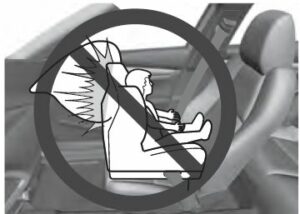 (Mexico)
(Mexico)
NEVER use a rearward facing child restraint on a seat protected by an ACTIVE AIRBAG in front of it, DEATH or SERIOUS INJURY to the CHILD can occur. Vehicles with a front passenger air bag have the following warning label. The warning label reminds you not to put a rear-facing child-restraint system on the front passenger seat at any time.
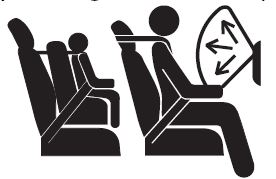 (Except Mexico) Vehicles with a front passenger air bag have the following warning label. The warning label reminds you not to put a rear-facing child-restraint system on the front passenger seat at any time. Do not install a front-facing child-restraint system on the front passenger seat unless it is unavoidable: In a collision, the force of a deploying air bag could cause serious injury or death to the child. If installing a front-facing child-restraint system on the front passenger seat is unavoidable, move the front passenger seat as far back as possible.
(Except Mexico) Vehicles with a front passenger air bag have the following warning label. The warning label reminds you not to put a rear-facing child-restraint system on the front passenger seat at any time. Do not install a front-facing child-restraint system on the front passenger seat unless it is unavoidable: In a collision, the force of a deploying air bag could cause serious injury or death to the child. If installing a front-facing child-restraint system on the front passenger seat is unavoidable, move the front passenger seat as far back as possible. 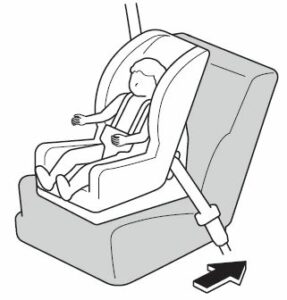 Setting a child in a child-restraint system on the front passenger seat is dangerous under certain conditions
Setting a child in a child-restraint system on the front passenger seat is dangerous under certain conditions
(With Front Passenger Occupant Classification System):
Your vehicle is equipped with front passenger seat weight sensors. Even with the front passenger seat weight sensors, if you must use the front passenger seat to seat a child, using a child-restraint system on the front passenger seat under the following conditions increases the danger of the front passenger air bag deploying and could result in serious injury or death to the child.
- The front passenger air bag deactivation indicator light does not illuminate when seating a child in the child-restraint system.
- Luggage or other items are placed on the seat with the child in the child-restraint system.
- A rear passenger or luggage pushing or pulling down on the front passenger seatback.
- Luggage or other items are placed on the seatback or hung on the head restraint.
- The seat is washed.
- Liquids are spilled on the seat.
- The front passenger seat is moved backward, pushing into luggage or other items placed behind it.
- The front passenger seatback contacts the rear seat.
- Luggage or other items are placed between the front passenger seat and driver seat.
- An electric device is put on the front passenger’s seat.
- An additional electrical device, such as a seat warmer is installed to the surface of the front passenger seat.
- Any accessories, which might increase the total seated weight on the front passenger seat, are attached to the front passenger seat.
The designated positions with seat belts on the rear seats are the safest places for children. Always use seat belts and child restraints.
Do not allow a child or anyone to lean over to or against the side window of a vehicle with side and curtain air bags:
It is dangerous to allow anyone to lean over to or against the side window, the area of the front passenger seat, the front and rear window pillars and the roof edge along both sides from which the side and curtain air bags deploy, even if a child-restraint system is used. The impact of inflation from a side or curtain air bag could cause serious injury or death to an out of position child. Furthermore, leaning over to or against the door could block the side and curtain air bags and eliminate the advantages of supplemental protection. Because the front seats are equipped with front air bags, the rear seat is always a better location for children. Take special care not to allow a child to lean over to or against the side window, even if the child is seated in a child-restraint system.
Never use one seat belt on more than one person at a time:
Using one seat belt for more than one person at a time is dangerous. A seat belt used in this way cannot spread the impact forces properly and the two passengers could be crushed together and seriously injured or even killed. Never use one belt for more than one person at a time and always operate the vehicle with each occupant properly restrained.
CAUTION
A seat belt or child-restraint system can become very hot in a closed vehicle during warm weather. To avoid burning yourself or a child, check them before you or your child touches them.
NOTE
Your Mazda is equipped with ISOFIX/LATCH*1 lower anchors for attachment of specially designed ISOFIX/LATCH*1 child-restraint systems on the rear seats. When using these anchors to secure a child-restraint system, refer to “Using ISOFIX Lower Anchor (Mexico)/Using LATCH Lower Anchor (Except Mexico)” . ISOFIX (Mexico)/LATCH (Except
Child-Restraint System Installation
Categories of Child-Restraint Systems NOTE When purchasing, ask the manufacturer of the child-restraint system which type of child-restraint system is appropriate for your child and vehicle.
(Mexico)
Child-restraint systems are classified into the following 5 groups according to the UN-R 44 and UN-R 129 regulation.
| Group | Age | Weight | Size Classification/ Fixture (CRF) |
| 0 | Up to about 9 months old | Up to 10 kg (up to 22 lb) | ISO/L1 |
| ISO/L2 | |||
| ISO/R1 | |||
| 0+ | Up to about 2 years old | Up to 13 kg (up to 29 lb) | ISO/R1 |
| ISO/R2 | |||
| ISO/R3 | |||
| 1 | About 8 months to 4 years old | 9 kg ― 18 kg (20 lb ― 40 lb) | ISO/R2 |
| ISO/R3 | |||
| ISO/F2 | |||
| ISO/F2X | |||
| ISO/F3 | |||
| 2 | About 3 to 7 years old | 15 kg ― 25 kg (33 lb ― 55 lb) | ― |
| 3 | About 6 to 12 years old | 22 kg ― 36 kg (48 lb ― 79 lb) | ― |
(Except Mexico) Please comply with the legal regulations concerning the use of child-restraint systems in your country.
Child-Restraint System Types
In this owner’s manual, explanation of child-restraint systems is provided for the following three types of popular child-restraint systems: infant seat, child seat, booster seat.
NOTE
- Installation position is determined by the type of child-restraint system. Always read the manufacturer’s instructions and this owner’s manual carefully.
- Due to variations in the design of child-restraint systems, vehicle seats and seat belts, all child-restraint systems may not fit all seating positions. Before purchasing a child-restraint system, it should be tested in the specific vehicle seating position (or positions) where it is intended to be used. If a previously purchased child-restraint system does not fit, you may need to purchase a different one that will.
Infant seat
An infant seat provides restraint by bracing the infant’s head, neck and back against the seating surface. Equal to Group 0 and 0+ of the UN-R 44 and UN-R 129 regulation.
 Child seat
Child seat
A child seat restrains a child’s body using the harness. Equal to Group 1 of the UN-R 44 and UN-R 129 regulations. Booster seat
Booster seat
A booster seat is a child restraint accessory designed to improve the fit of the seat belt system around the child’s body. Equal to Group 2 and 3 of the UN-R 44 and UN-R 129 regulation.
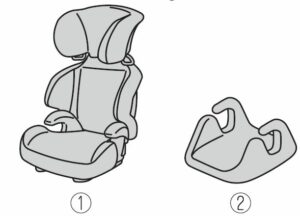
- Full booster seat
- Backless booster seat
When using a backless booster seat, always install the vehicle head restraint to the seat where the backless booster seat is installed.
Child-Restraint System Suitability for Various Seat Positions Table
Child-Restraint System Suitability for Various Seat Positions Table (Mexico) Provided information in the table shows your child-restraint system suitability for various seating position. For installation suitability of other manufacturer child-restraint system, carefully consult the manufacturer’s instructions which accompany the child-restraint system. When installing a child-restraint system, the following points must be observed:
- Always remove the head restraint before installing a child-restraint system. However, when installing a backless booster seat, always install the vehicle head restraint to the seat where the backless booster seat is installed. In addition, always use a tether strap and attach it securely.
- When installing a child-restraint system to the front passenger seat, adjust the seat slide position as far back as possible.
- When it is difficult to install a child-restraint system to the front passenger seat, or the seat belt cannot be secured to the child-restraint system, perform the following operations to adjust the seat holding the child-restraint system so that the seat belt can be secured completely to it.
- Move the seat forward or back.
- Move the seatback forward or back.
- Move the seat upward or downward.
- (Vehicles with height adjustment function)
- When installing a child-restraint system to the rear seat, adjust the front seat position so that the front seat does not contact the child-restraint system.
- When installing a child-restraint system equipped with a tether, remove the head restraint.
- An i-Size child-restraint system refers to a child-restraint system which has acquired i-Size category certification for the UN-R 129 regulation.
- When installing a child-restraint system to the rear seat,
| Seating position | Passenger | Rear (Left) | Rear (Center) | Rear (Right) |
| Seating position suitable for universal belted (Yes/No) | Yes (UF) | Yes (U) | Yes (U) | Yes (U) |
| Size seating position (Yes/No) | No | No | No | No |
| Largest suitable rearward facing fixture (R1) | No | Yes (IL) | No | Yes (IL) |
| Largest suitable rearward facing fixture (R2) | No | Yes (IL) | No | Yes (IL) |
| Largest suitable rearward facing fixture (R2X) | No | Yes (IL) | No | Yes (IL) |
| Largest suitable rearward facing fixture (R3) | No | Yes (IL) | No | Yes (IL) |
| Largest suitable for- ward facing fixture (F2) | No | Yes (IUF) | No | Yes (IUF) |
| Largest suitable for- ward facing fixture (F2X) | No | Yes (IUF) | No | Yes (IUF) |
| Largest suitable for- ward facing fixture (F3) | No | Yes (IUF) | No | Yes (IUF) |
| Largest suitable lateral facing fixture (L1) | No | No | No | No |
| Largest suitable lateral facing fixture (L2) | No | No | No | No |
| Largest suitable booster fixture (B2) | No | Yes (IUF) | No | Yes (IUF) |
| Largest suitable booster fixture (B3) | No | Yes (IUF) | No | Yes (IUF) |
| Seating position | Passenger | Rear (Left) | Rear (Center) | Rear (Right) |
| Non i-size compatible with a support leg (Yes/No | Yes*1 | Yes | No | Yes |
| Lower ISOFIX an- chorages but with- out Top Tether (Yes/No) | No | No | No | No |
U = Suitable for “universal” category restraints approved for use in this mass group. UF = Suitable for forward-facing “universal” category restraints approved for use in this mass group. IUF = Suitable for ISOFIX forward child restraints systems of universal category approved for use in the mass group. L = Suitable for particular child restraints given on attached list. These restraints may be of the “specific vehicle”, “restricted” or “semi-universal” categories. IL = Suitable for particular ISOFIX child restraint systems (CRS) given in the attached list. These ISOFIX CRS are those of the “specific vehicle”, “restricted” or “semi-universal” categories. i-U = Suitable for i-Size “universal” Child Restraint Systems forward and rearward facing. i-UF = Suitable for forward-facing i-Size “universal” Child Restraint Systems only. Yes = Child-restraint system can be secured on the seat. No = Child-restraint system cannot be secured on the seat, or there is no fixture. X = Child-restraint system cannot be installed. *1 Child restraint system can only be installed in the forward-facing position. A Mazda genuine child-restraint system can be installed. Regarding child-restraint systems which can be installed, refer to the accessories catalog.
(Except Mexico)
- Regarding child-restraint systems which can be installed to your Mazda, consult an Authorized Mazda Dealer.
- A child-restraint system with a support leg cannot be installed on the rear center seat position.
- Please comply with the legal regulations concerning the use of child-restraint systems in your country.
- For the CRS which do not carry the ISO/XX size class identification (A to G), for the applicable mass group, the child seat manufacturer shall indicate the vehicle specific LATCH child-restraint systems recommended for each position.
Installing Child-Restraint Systems
Installing Child-Restraint Systems
Accident statistics reveal that a child is safer in the rear seat. The front passenger’s seat is clearly the worst choice for any child under 12, and with rear-facing child-restraint systems it is clearly unsafe due to air bags.
NOTE Even if your vehicle is equipped with front passenger occupant classification sensor (page 2-70), which automatically deactivates the front passenger air bag, a rear seat is the safest place for a child of any age or size. Some child-restraint systems now come with tethers and therefore must be installed on the seats that take tethers to be effective. In your Mazda, tethered child-restraint systems can only be accommodated in the three positions on the rear seat. Some child-restraint systems also employ specially designed ISOFIX/LATCH*1 attachments; refer to “Using ISOFIX Lower Anchor (Mexico)/Using LATCH Lower Anchor (Except Mexico)” .
ISOFIX (Mexico)/LATCH (Except Mexico) WARNING Tethered Child-Restraint Systems Work Only on Tether-Equipped Rear Seats:
Installation of a tether equipped child-restraint system in the front passenger’s seat defeats the safety design of the system and will result in an increased chance of serious injury if the child-restraint system goes forward without benefit of being tethered. Place tether equipped child-restraint systems where there are tether anchors.
Anchor Bracket Anchor brackets for securing
child-restraint systems are equipped in the vehicle. Locate each anchor position using the illustration. To install a child-restraint system, remove the head restraint. Always follow the instruction manual accompanying the child-restraint system.
Anchor bracket location
Use the indicated anchor bracket locations when installing a child-restraint system equipped with a tether. 
- For right
- For center (Except Mexico)
- For left
- 4 Anchor bracket
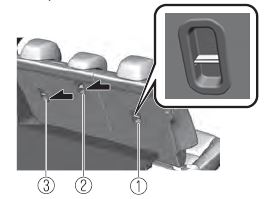
- For right
- For center (Except Mexico)
- For left
WARNING Always attach the tether strap to the correct tether anchor position:
Attaching the tether strap to the incorrect tether anchor position is dangerous. In a collision, the tether strap could come off and loosen the child-restraint system. If the child-restraint system moves it could result in death or injury to the child. Always remove the head restraint and install child-restraint system: Installing a child-restraint system without removing the head restraint is dangerous. The child-restraint system cannot be installed correctly which may result in death or injury to the child in a collision.
(Mexico)
If the top tether strap does not reach the anchor bracket, purchase and use an extension strap provided by the CRS manufacturer.
(4–Door)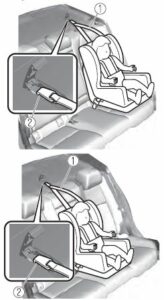
- Tether strap
- Anchor bracket

- Tether strap
- Anchor bracket
- Forward
Always install the head restraint and adjust it to the appropriate position after removing the child-restraint system:
Driving with the head restraint removed is dangerous as impact to the occupant’s head cannot be prevented during emergency braking or in a collision, which could result in a serious accident, injury or death.
Using Automatic Locking Mode (Except Mexico)
Follow these instructions when using a child-restraint system, unless you are attaching a LATCH-equipped child-restraint system to the rear LATCH lower anchors. Refer to “Using LATCH Lower Anchor”
NOTE
Follow the child-restraint system manufacturer’s instructions carefully. If you are not sure whether you have a LATCH system or tether, check in the child-restraint system manufacturer’s instructions and follow them accordingly. Depending on the type of child-restraint system, it may use LATCH system instead of seat belts or if the belt goes across the child’s chest, may recommend against using automatic locking mode.
- Make sure the seatback is securely latched by pushing it back until it is fully locked.
- Remove the head restraint. However, when installing a backless booster seat, always install the vehicle head restraint to the seat where the backless booster seat is installed. Refer to Head Restraints.
- Secure the child-restraint system with the lap portion of the lap/shoulder belt. See the manufacturer’s instructions on the child-restraint system for belt routing instructions.
- To get the retractor into the automatic locking mode, pull the shoulder belt portion of the seat belt until the entire length of the belt is out of the retractor.

- Push the child-restraint system firmly into the vehicle seat. Be sure the belt retracts as snugly as possible. A clicking noise from the retractor will be heard during retraction if the system is in the automatic locking mode. If the belt does not lock the seat down tight, repeat this step.
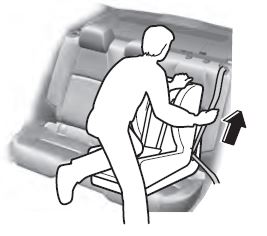
NOTE
- Inspect this function before each use of the child-restraint system. You should not be able to pull the shoulder belt out of the retractor while the system is in the automatic locking mode. When you remove the child-restraint system, be sure the belt fully retracts to return the system to emergency locking mode before occupants use the seat belts.
- If your child-restraint system requires the use of a tether strap, refer to the manufacturer’s instructions to hook and tighten the tether strap.
WARNING Use the tether and tether anchor only for a child-restraint system:
Using the tether or tether anchor to secure anything but a child-restraint system is dangerous. This could weaken or damage the tether or tether anchor and result in injury.
Always remove the head restraint and install child-restraint system (except when installing a backless booster seat): Installing a child-restraint system without removing the head restraint is dangerous. The child-restraint system cannot be installed correctly which may result in death or injury to the child in a collision.
(4–Door)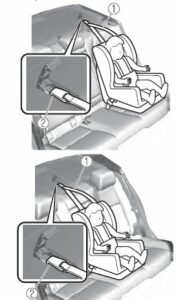
- Tether strap
- Anchor bracket
(5–Door)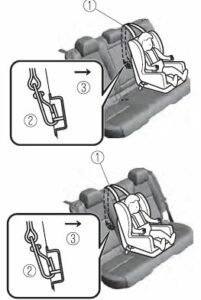
- Tether strap
- Anchor bracket
- Forward
Always attach the tether strap to the correct tether anchor position: Attaching the tether strap to the incorrect tether anchor position is dangerous. In a collision, the tether strap could come off and loosen the child-restraint system. If the child-restraint system moves it could result in death or injury to the child.
Always install the head restraint and adjust it to the appropriate position after removing the child-restraint system:
Driving with the head restraint removed is dangerous as impact to the occupant’s head cannot be prevented during emergency braking or in a collision, which could result in a serious accident, injury or death. Refer to Head Restraints.
If You Must Use the Front Seat for Children
If you cannot put all children in the rear seat, at least put the smallest children in the rear and be sure the largest child up front uses the shoulder belt over the shoulder. NEVER put a rear-facing child-restraint system on the front passenger seat whether your vehicle is equipped with an occupant classification sensor or not. This seat is also not set up for tethered child-restraint systems, put them in one of the rear seat positions set up with tether anchors.
Likewise the ISOFIX/LATCH*1
child-restraint system cannot be secured in the front passenger’s seat and should be used in the rear seat. Do not allow anyone to sleep against the side window since your vehicle has side and curtain air bags, it could cause serious injuries to an out of position occupant. As children more often sleep in cars, it is better to put them in the rear seat. If installing the child-restraint system on the front seat is unavoidable, follow these instructions when using a front-facing child-restraint system in the front passenger’s seat.
*1 ISOFIX (Mexico)/LATCH (Except Mexico)
NOTE
- To check if your front seats have side air bags: Mazda vehicles equipped with side air bag will have a “SRS AIRBAG” tag on the outboard shoulder of the front seats.
Always move the front passenger seat as far back as possible if installing a front-facing child-restraint system on it is unavoidable:
As your vehicle has front air bags and doubly so because your vehicle has side air bags, a front-facing child-restraint system should be put on the front passenger seat only when it is unavoidable. Even if the front passenger air bag deactivation indicator light illuminates, always move the seat as far back as possible, because the force of a deploying air bag could cause serious injury or death to the child.
Never use a rear-facing child-restraint system in the front seat with an air bag that could deploy:
Rear-facing child-restraint systems on the front seat are particularly dangerous. Even in a moderate collision, the child-restraint system can be hit by a deploying air bag and moved violently backward resulting in serious injury or death to the child. Even though you may feel assured that the front passenger air bag will not deploy based on the fact that the front passenger air bag deactivation indicator light illuminates, you should not use a rear-facing child-restraint system in the front seat.
Do not allow a child or anyone to lean over to or against the side window of a vehicle with side and curtain air bags:
It is dangerous to allow anyone to lean over to or against the side window, the area of the front passenger seat, the front and rear window pillars and the roof edge along both sides from which the side and curtain air bags deploy, even if a child-restraint system is used. The impact of inflation from a side or curtain air bag could cause serious injury or death to an out of position child. Furthermore, leaning over to or against the door could block the side and curtain air bags and eliminate the advantages of supplemental protection. Because the front seats are equipped with front air bags, the rear seat is always a better location for children. Take special care not to allow a child to lean over to or against the side window, even if the child is seated in a child-restraint system.
Always remove the head restraint and install child-restraint system (except when installing a backless booster seat):
Installing a child-restraint system without removing the head restraint is dangerous. The child-restraint system cannot be installed correctly which may result in death or injury to the child in a collision.
Always install the head restraint and adjust it to the appropriate position after removing the child-restraint system:
Driving with the head restraint removed is dangerous as impact to the occupant’s head cannot be prevented during emergency braking or in a collision, which could result in a serious accident, injury or death. Refer to Head Restraints.
Front Passenger’s Seat Child-Restraint System Installation (With Front Passenger Occupant Classification System)
- Make sure the ignition is switched off.
- Slide the seat as far back as possible.
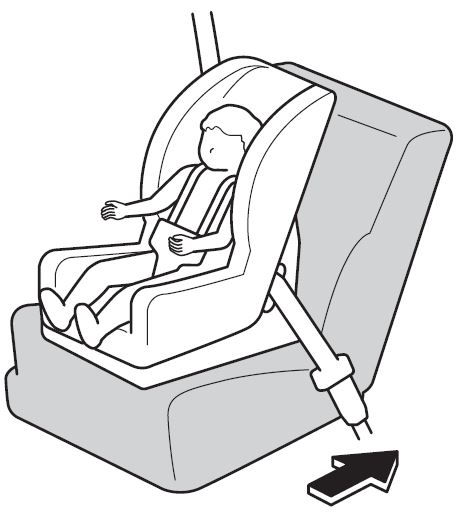
- Remove the head restraint. However, when installing a backless booster seat, always install the vehicle head restraint to the seat where the backless booster seat is installed. Place the child-restraint system on the seat without putting your weight on the seat and fasten the seat belt. See the manufacturer’s instructions on the child-restraint system for belt routing instructions.
- To get the retractor into the automatic locking mode, pull the shoulder belt portion of the seat belt until the entire length of the belt is out of the retractor.
- Push the child-restraint system firmly into the vehicle seat. Be sure the belt retracts as snugly as possible. A clicking noise from the retractor will be heard during retraction if the system is in automatic locking mode. If the belt does not lock the seat down tight, repeat the previous step and also this one.
NOTE
- Inspect this function before each use of the child-restraint system. You should not be able to pull the shoulder belt out of the retractor while the system is in the automatic locking mode. When you remove the child-restraint system, be sure the belt fully retracts to return the system to emergency locking mode before occupants use the seat belts. Follow the child-restraint system manufacturer’s instructions carefully. Depending on the type of child-restraint system, it may not employ seat belts which are in automatic locking mode. Seat your child safely in the child-restraint system and secure the child according to the instructions from the child-restraint system manufacturer. Switch the ignition ON and make sure the front passenger air bag deactivation indicator light illuminates after installing a child-restraint system on the front passenger seat. If the front passenger air bag deactivation indicator light does not illuminate, remove the child-restraint system, switch the ignition to OFF, and then re-install the child-restraint system.
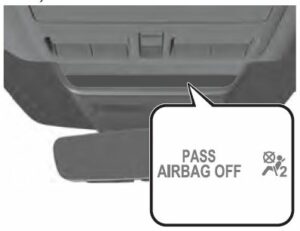 WARNING
WARNING
Do not seat a child in a child-restraint system on the front passenger seat if the front passenger air bag deactivation indicator light does not illuminate:
While it is always better to install any child-restraint system on the rear seat, it is imperative that a child-restraint system ONLY be used on the front passenger seat if the deactivation indicator light illuminates when the child is seated in the child-restraint system . Seating a child in a child-restraint system installed on the front passenger seat with the front passenger air bag deactivation indicator light not illuminated is dangerous. If this indicator light does not illuminate, this means that the front passenger front and side air bags, and knee air bags, and seat belt pretensioners are ready for deployment. If an accident were to deploy an air bag, a child in a child-restraint system sitting in the front passenger seat could be seriously injured or killed. If the indicator light does not illuminate after seating a child in a child-restraint system on the front passenger seat, seat a child in a child-restraint system on the rear seat and consult an Authorized Mazda Dealer as soon as possible.
Using ISOFIX Lower Anchor (Mexico)/Using LATCH Lower Anchor (Except Mexico)
Your Mazda is equipped with ISOFIX/LATCH*1 lower anchors for attachment of specially designed ISOFIX/LATCH*1 child-restraint systems in the rear seats. Both anchors must be used, otherwise the seat will bounce around and put the child in danger. Most ISOFIX/LATCH*1 child-restraint systems must also be used in conjunction with a tether to be effective. If they have a tether you must use it to better assure your child’s safety.
Follow the manufacturer’s instructions for the use of the child-restraint system:
An unsecured child-restraint system is dangerous. In a sudden stop or a collision it could move causing serious injury or death to the child or other occupants. Make sure the child-restraint system is properly secured in place according to the child-restraint system manufacturer’s instructions.
Never attach two child-restraint systems to the same ISOFIX/LATCH*1 lower anchor:
Attaching two child-restraint systems to the same ISOFIX/LATCH*1 lower anchor is dangerous. In a collision, one anchor may not be strong enough to hold two child-restraint system attachments, and it may break, causing serious injury or death. If you use the seat position for another child-restraint system when an outboard ISOFIX/LATCH*1 position is occupied, use the center seat belts instead, and the tether if tether-equipped.
Make sure the child-restraint system is properly secured:
An unsecured child-restraint system is dangerous. In a sudden stop or a collision it could move causing serious injury or death to the child or other occupants. Follow the child-restraint system manufacturer’s instructions on belt routing to secure the seat just as you would with a child in it so that nobody is tempted to put a child in an improperly secured seat later on. When not in use, remove it from the vehicle or fasten it with a seat belt, or attach it to BOTH ISOFIX/LATCH*1 lower anchors for ISOFIX/LATCH*1 child-restraint systems. Make sure there are no seat belts or
foreign objects near or around the ISOFIX/LATCH*1 child-restraint system:
Not following the child-restraint system manufacturer’s instructions when installing the child-restraint system is dangerous. If seat belts or a foreign object prevent the child-restraint system from being securely attached to the ISOFIX/LATCH*1 lower anchors and the child-restraint system is installed improperly, the child-restraint system could move in a sudden stop or collision causing serious injury or death to the child or other occupants. When installing the child-restraint system, make sure there are no seat belts or foreign objects near or around the ISOFIX/LATCH*1 lower anchors. Always follow the child-restraint system manufacturer’s instructions.
1 ISOFIX (Mexico)/LATCH (Except Mexico) Installation on rear outboard seats
- First, adjust the front seat to allow clearance between the child-restraint system and the front seat. Refer to Adjusting the Driver’s Seat on page 2-5. Refer to Adjusting the Front Passenger’s Seat.
- Make sure the seatback is securely latched by pushing it back until it is fully locked.
- Remove the cover of the child-restraint system’s ISOFIX/LATCH*1 lower anchors to verify the locations of the ISOFIX/LATCH*1 lower anchors.
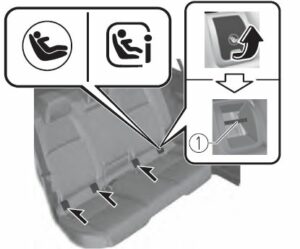
- Lower anchor NOTE
- The ISOFIX/LATCH*1 lower anchors marking on the cover indicates the position of the ISOFIX/LATCH*1 lower anchors for the attachment of a child-restraint system.
- Store the removed cover so that it does not get lost.
- Lower anchor NOTE
- Remove the head restraint. However, when installing a backless booster seat, always install the vehicle head restraint to the seat where the backless booster seat is installed. Refer to Head Restraints.
- Secure the child-restraint system using BOTH ISOFIX/LATCH*1 lower anchors, following the child-restraint system manufacturer’s instruction. Pull on the child-restraint to be sure both anchors are engaged.
- If your child-restraint system came equipped with a tether, that means it is very important to properly secure the tether for child safety. Please carefully follow the child-restraint system manufacturer’s instructions when installing tethers.
ISOFIX (Mexico)/LATCH (Except Mexico) WARNING Use the tether and tether anchor only for a child-restraint system:
Using the tether or tether anchor to secure anything but a child-restraint system is dangerous. This could weaken or damage the tether or tether anchor and result in injury.
Always remove the head restraint and install child-restraint system (except when installing a backless booster seat):
Installing a child-restraint system without removing the head restraint is dangerous. The child-restraint system cannot be installed correctly which may result in death or injury to the child in a collision.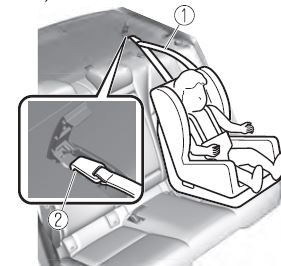
- Tether strap
- Anchor bracket
(5–Door) - Tether strap
- Anchor bracket
- Forward
- Anchor bracket
Always attach the tether strap to the correct tether anchor position: Attaching the tether strap to the incorrect tether anchor position is dangerous. In a collision, the tether strap could come off and loosen the child-restraint system. If the child-restraint system moves it could result in death or injury to the child.
Always install the head restraint and adjust it to the appropriate position after removing the child-restraint system:
Driving with the head restraint removed is dangerous as impact to the occupant’s head cannot be prevented during emergency braking or in a collision, which could result in a serious accident, injury or death. Refer to Head Restraints. Always attach the tether strap to the correct tether anchor position: Attaching the tether strap to the incorrect tether anchor position is dangerous. In a collision, the tether strap could come off and loosen the child-restraint system. If the child-restraint system moves it could result in death or injury to the child.
Always install the head restraint and adjust it to the appropriate position after removing the child-restraint system:
Driving with the head restraint removed is dangerous as impact to the occupant’s head cannot be prevented during emergency braking or in a collision, which could result in a serious accident, injury or death. Refer to Head Restraints.
Installation on rear center seat
The ISOFIX/LATCH*1 lower anchors at the center of the rear seat are much further apart than the sets of ISOFIX/LATCH*1 lower anchors for child-restraint system installation at other seating positions. Child-restraint systems with rigid ISOFIX/LATCH*1 attachments cannot be installed on the center seating position. Some ISOFIX/LATCH*1 equipped child-restraint systems can be placed in the center position and will reach the nearest ISOFIX/LATCH*1 lower anchors which are 434 mm (17.1 in) apart. ISOFIX/LATCH*1 compatible child-restraint systems (with attachments on belt webbing) can be used at this seating position only if the child-restraint system manufacturer’s instructions state that the child-restraint system can be installed to ISOFIX/LATCH*1 lower anchors that are 434 mm (17.1 in) apart. Do not attach two child-restraint systems to the same ISOFIX/LATCH*1 lower anchor. If your child-restraint system has a tether, it must also be used for your child’s optimum safety. The procedure is the same as the installation for the rear outboard seats. *1 ISOFIX (Mexico)/LATCH (Except Mexico)
ISOFIX/LATCH*1 lower anchor location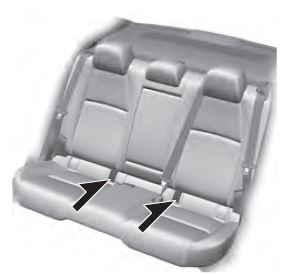 WARNING
WARNING
Always remove the head restraint and install child-restraint system (except when installing a backless booster seat):
Installing a child-restraint system without removing the head restraint is dangerous. The child-restraint system cannot be installed correctly which may result in death or injury to the child in a collision.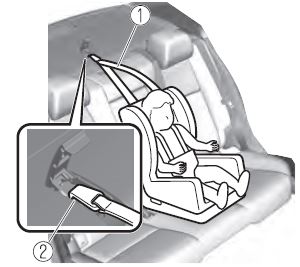
- Tether strap
- Anchor bracket
(5–Door)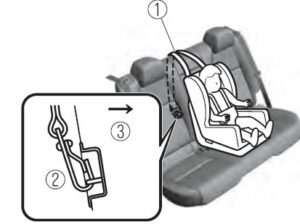
- Tether strap
- Anchor bracket
- Forward
Always attach the tether strap to the correct tether anchor position: Attaching the tether strap to the incorrect tether anchor position is dangerous. In a collision, the tether strap could come off and loosen the child-restraint system. If the child-restraint system moves it could result in death or injury to the child.
Always install the head restraint and adjust it to the appropriate position after removing the child-restraint system:
Driving with the head restraint removed is dangerous as impact to the occupant’s head cannot be prevented during emergency braking or in a collision, which could result in a serious accident, injury or death. Refer to Head Restraints. *1ISOFIX (Mexico)/LATCH (Except Mexico)
FAQs
The Mazda 3 Hatchback 2023 has a variety of child restraint options, such as rear-facing infant seats, forward-facing convertible seats, and booster seats.
It is recommended that newborns and infants use a rear-facing infant seat until they are at least two years old, or until they reach the maximum weight or height limit specified by the car seat manufacturer.
A forward-facing convertible seat can be installed in the Mazda 3 Hatchback 2023. For proper installation, make sure to follow the manufacturer’s instructions.
The minimum age and weight requirements for using a forward-facing convertible seat vary by car seat model. For accurate information, consult the car seat manufacturer’s guidelines.
When your child outgrows the forward-facing convertible seat, you can use a booster seat in the Mazda 3 Hatchback 2023. Booster seats are intended to raise the child and correctly position the seat belt.
Typically, the recommended age and weight range for using a booster seat begins around four years old and 40 pounds (18 kilograms). However, it is critical to adhere to the specific instructions provided by the booster seat manufacturer.
Yes, the Mazda 3 Hatchback 2023 has the LATCH (Lower Anchors and Tethers for Children) system, which enables the secure installation of compatible child restraints.
Yes, you can install a child restraint in the Mazda 3 Hatchback 2023 using the seat belt. Follow the instructions provided by the car seat manufacturer to ensure a secure installation.
Yes, you can install a child restraint in the Mazda 3 Hatchback 2023 using the seat belt. Follow the instructions provided by the car seat manufacturer to ensure a secure installation.
While a child restraint can be installed in the front passenger seat, it is generally safer to place children in the rear seat, especially the back seat, to reduce the risk of injury from airbags.
The Mazda 3 Hatchback 2023 includes standard safety features such as child safety locks, airbags, and seat belt pretensioners to improve overall passenger safety, including those in child restraints.
There is no specific height or weight for the Mazda 3 Hatchback 2023. Use of rear seats with child restraints is restricted. However, it is critical to follow the manufacturer’s instructions for proper use.
Yes, ISOFIX-compatible child restraints are compatible with the Mazda 3 Hatchback 2023. The ISOFIX standard is used to design the vehicle’s LATCH system.
Child restraint laws and regulations differ by country, state, or region. When using child restraints in the Mazda 3 Hatchback 2023, it’s critical to familiarize yourself with local laws and regulations and to follow them.
For more information on child restraints compatible with the Mazda 3 Hatchback 2023, consult the vehicle’s owner’s manual, contact your local Mazda dealership, or visit the official Mazda website.
Useful Links
View Full User Guide: Mazda 3 Hatchback 2023 User Manual| Auto User Guide
Download Link: Owner’s – Manuals, Guides, Maintenance Schedules | Mazda USA

